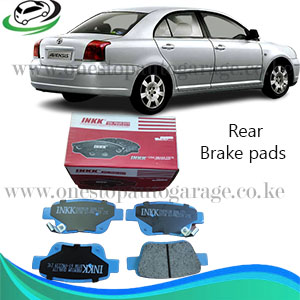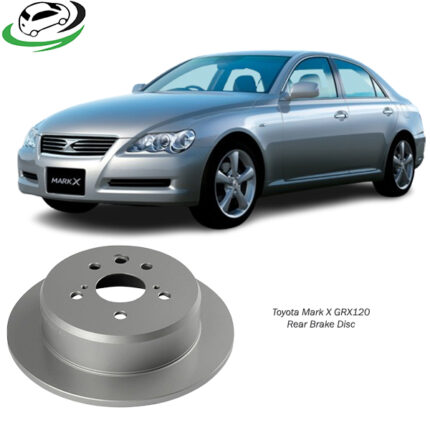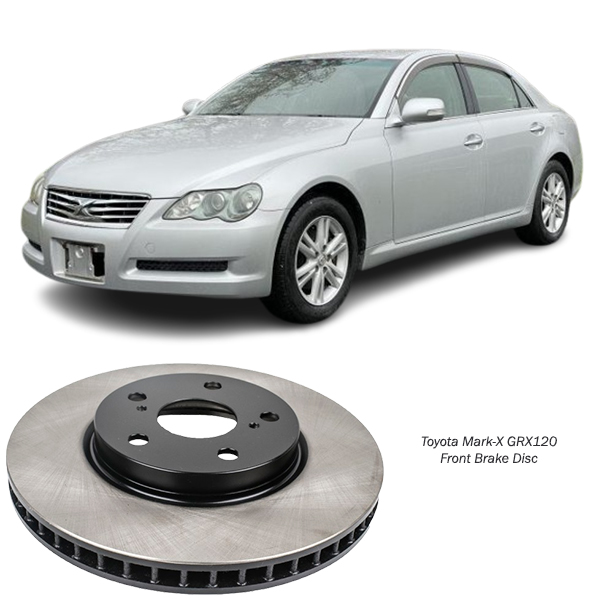-8%
Get Toyota Mark-X GRX120 Front Brake Disc 43512-30310 in Kenya
The front brake disc, commonly referred to as a rotor, is a vital component in a vehicle’s braking system. It plays a pivotal role in ensuring safe and efficient braking by providing a surface for the brake pads to press against, converting kinetic energy into heat, and slowing down the vehicle. This guide delves into the functions, construction, benefits, types, maintenance, and considerations for front brake discs in detail.
What Is a Front Brake Disc?
The front brake disc is a circular, metallic component attached to the wheel hub of a vehicle. When you press the brake pedal, the brake caliper squeezes the brake pads against the disc, creating friction. This friction slows the wheel’s rotation, reducing the vehicle’s speed or bringing it to a halt.
Functions of a Front Brake Disc
- Friction Surface: Provides a surface for the brake pads to apply pressure, generating the necessary friction to slow down the vehicle.
- Heat Dissipation: Converts kinetic energy into heat and dissipates it to prevent the braking system from overheating.
- Stopping Power: Works in tandem with other braking components to provide reliable stopping performance.
- Stable Performance: Ensures consistent braking under varying driving conditions, including high speeds or heavy loads.
Components of a Front Brake Disc
- Rotor Disc: The primary component, made of durable materials like cast iron or composites, to withstand high temperatures and pressure.
- Cooling Vanes: Found in ventilated discs, these vanes allow airflow to cool the disc.
- Mounting Holes: Facilitate secure attachment to the wheel hub.
- Friction Surface: Smooth surfaces on either side of the disc where brake pads make contact.
Types of Front Brake Discs
The design and material of brake discs vary to suit different driving needs and vehicle types. Here are the common types:
- Solid Discs:
- Feature a simple, solid design.
- Common in smaller or less powerful vehicles.
- Offer adequate performance for everyday driving.
- Ventilated Discs:
- Feature internal cooling vanes to improve heat dissipation.
- Found in most modern passenger cars and light trucks.
- Provide better performance under continuous or heavy braking.
- Drilled Discs:
- Have holes drilled through the rotor to reduce weight and improve cooling.
- Offer enhanced performance for high-speed or high-performance vehicles.
- May be prone to cracking under extreme conditions.
- Slotted Discs:
- Feature grooves on the surface to remove debris and improve pad contact.
- Ideal for performance-oriented or off-road vehicles.
- Provide consistent braking in harsh environments.
- Composite Discs:
- Combine materials like carbon-ceramic for superior performance.
- Lightweight and resistant to heat, making them ideal for sports cars.
- Expensive but offer excellent durability and braking performance.
Benefits of Front Brake Discs
- Enhanced Safety:
- Reliable stopping power is crucial for accident prevention.
- Front brake discs contribute significantly to overall braking efficiency.
- Improved Performance:
- Provide smooth, consistent braking even under high-speed or heavy-load conditions.
- Designed to handle repeated use without significant performance loss.
- Durability:
- High-quality discs are built to withstand extreme conditions, including high temperatures and pressure.
- Heat Resistance:
- Advanced designs, like ventilated or composite discs, ensure effective heat dissipation, reducing the risk of brake fade.
- Reduced Maintenance:
- Longer service life compared to older drum brake systems.
- Easier to inspect and replace than other braking components.
Signs of Wear or Damage
Front brake discs are subject to constant wear and tear. Common signs that indicate issues include:
- Vibration During Braking:
- Warped or uneven discs can cause vibrations when braking.
- Squealing or Grinding Noise:
- Worn or damaged discs often produce noise due to uneven surfaces or contact with worn pads.
- Reduced Braking Performance:
- Longer stopping distances or decreased responsiveness can indicate worn discs.
- Visible Damage:
- Cracks, scoring, or discoloration on the disc surface suggest excessive wear or overheating.
- Pulling to One Side:
- Uneven disc wear can cause the vehicle to pull to one side during braking.
Maintenance and Replacement
Maintaining the front brake discs is crucial for ensuring the safety and performance of the braking system. Here are some tips:
Inspection
- Inspect the discs regularly for signs of wear, warping, or damage.
- Check for uneven wear, grooves, or cracks on the surface.
Replacement Intervals
- Replace discs when they reach the minimum thickness specified by the manufacturer.
- Always replace discs in pairs to maintain balanced braking.
Cleaning
- Remove debris, dust, and rust to maintain optimal performance.
- Use brake cleaner to avoid contaminants that can affect braking efficiency.
Brake Pad Replacement
- Replace brake pads simultaneously with discs to ensure consistent performance.
- Worn pads can damage the disc surface if not replaced in time.
Choosing the Right Front Brake Disc
When selecting a front brake disc, consider the following factors:
- Vehicle Compatibility:
- Ensure the disc is designed for your vehicle’s make, model, and engine type.
- Driving Conditions:
- Opt for high-performance discs if you frequently drive at high speeds or in mountainous terrain.
- Choose ventilated or slotted discs for improved cooling under heavy loads.
- Material Quality:
- High-grade materials like cast iron or carbon-ceramic offer better durability and performance.
- Budget:
- While premium options provide superior performance, standard discs are sufficient for most everyday driving needs.
- Brand Reputation:
- Trusted brands like Brembo, Bosch, or ATE offer reliable and high-quality brake discs.
Cost of Front Brake Discs
The cost of front brake discs varies depending on their type, material, and brand. Here’s a general breakdown:
- Standard Solid Discs: $30-$60 per disc.
- Ventilated Discs: $50-$100 per disc.
- Performance Discs (Drilled/Slotted): $100-$300 per disc.
- Composite Discs (Carbon-Ceramic): $500-$1,000+ per disc.
Environmental Considerations
Used brake discs can be recycled to minimize environmental impact. When replacing discs, follow these steps:
- Dispose of Responsibly:
- Take worn discs to a recycling facility or automotive shop for proper disposal.
- Avoid Contaminants:
- Ensure that discarded discs are free from oil or grease, as these can affect recycling processes.
- Promote Sustainable Practices:
- Choose manufacturers who prioritize eco-friendly materials and practices.
Innovations in Front Brake Disc Technology
Modern advancements have significantly improved the performance and efficiency of front brake discs. Notable innovations include:
- Lightweight Materials:
- Use of composite materials reduces weight, enhancing fuel efficiency and handling.
- Enhanced Cooling Systems:
- Improved ventilated designs for better heat dissipation.
- Anti-Corrosion Coatings:
- Protects discs from rust and extends their lifespan.
- Noise-Reducing Designs:
- Advanced engineering minimizes brake noise for a smoother driving experience.
Conclusion
The front brake disc is a cornerstone of a vehicle’s braking system, providing the performance and reliability needed to ensure safe driving. Regular inspection, timely maintenance, and choosing the right disc type for your vehicle and driving conditions are crucial for optimal braking performance. By investing in high-quality front brake discs and adhering to proper maintenance practices, you ensure not only the safety of your vehicle but also the longevity of its braking components.
Follow us on Facebook for more parts.



